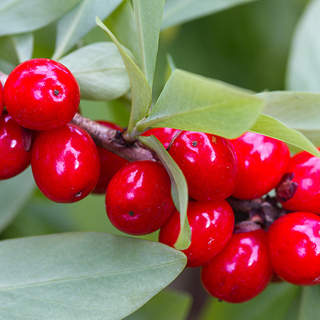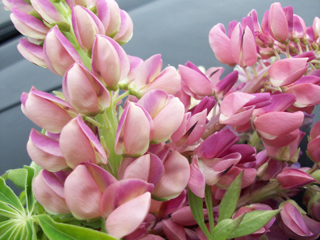 Sometimes I struggle to find a sufficiently interesting subject with which to entertain you. It is particularly difficult in the winter time when we have been experiencing torrential rains and outside work has been nigh on impossible. When attending social events or just chatting in the village I sometimes gain inspiration but this month has been difficult.
Sometimes I struggle to find a sufficiently interesting subject with which to entertain you. It is particularly difficult in the winter time when we have been experiencing torrential rains and outside work has been nigh on impossible. When attending social events or just chatting in the village I sometimes gain inspiration but this month has been difficult.
But as always it finally happened. I went to visit a friend and customer at Portscatho who had asked me to advise about moving some shrubs that would be in the way of some building works. Pointing to one of the shrubs he asked ’What’s this, I know you have told me before?’ Well it is a Daphne of some age and I told him that if he moved it successfully I would give up gardening. Daphnes do not like being moved and often fail even when being planted from pot to garden. All the other shrubs, hydrangeas, camellias in bud and a young cherry tree would move successfully but I suggested he leave it another month to ensure the majority were dormant. For some reason camellias in bud move quite happily at this time of year.
 On returning home I received an email from said friend. It read, ‘I have just discovered that Daphnes are poisonous, their leaves, berries and bark.’ He has grandchildren and therefore he suggested that if he moved it and it died it would be a good result. I am afraid he got a very short reply. I told him that many plants in the garden are poisonous to some extent and that my child had been brought up surrounded by poisonous plants and that perhaps it is better to train the child not to eat anything in the garden because to remove all plants that they might harmfully ingest would not leave us with much. He of course laughed and took the point but I have yet to hear the fate of the Daphne. I wish her well and hope she defies the odds and the rules.
On returning home I received an email from said friend. It read, ‘I have just discovered that Daphnes are poisonous, their leaves, berries and bark.’ He has grandchildren and therefore he suggested that if he moved it and it died it would be a good result. I am afraid he got a very short reply. I told him that many plants in the garden are poisonous to some extent and that my child had been brought up surrounded by poisonous plants and that perhaps it is better to train the child not to eat anything in the garden because to remove all plants that they might harmfully ingest would not leave us with much. He of course laughed and took the point but I have yet to hear the fate of the Daphne. I wish her well and hope she defies the odds and the rules.
That small episode set me thinking about poisonous plants because it is actually a very serious subject. Whilst some are instantly deadly others just react with some people and not others. We all know about foxgloves and deadly nightshade. We know that some irritate through their sap and that there are varying degrees of danger. For example brushing past a conifer in the summer brings me out in a red itchy rash for 24 hours but doesn’t affect me in the winter. (Note: Ingesting Daphne berries is normally fatal.)
At the risk of now writing a list I have highlighted some of the more common plants of which we should be aware. The list is far from exhaustive, there are thousands of plants that in some way can affect us and therefore I have picked out some of the more and less well known.
 The point really is that unlike the animal kingdom plants cannot move to escape a predator. Therefore they protect themselves from herbivorous animals by physical defences like thorns but more commonly by chemicals. Evolution has developed those defences and many medical advances have been made by understanding and using those defences. My list is compiled with reference to the Royal Horticultural Society and as I said is far from exhaustive. I have not dwelt on the types of chemical compound that cause the problems but those can be found through the RHS and now on plant labelling which is mandatory. I simply use the word poisonous or toxic which can mean it induces stomach upset and vomiting or worse.
The point really is that unlike the animal kingdom plants cannot move to escape a predator. Therefore they protect themselves from herbivorous animals by physical defences like thorns but more commonly by chemicals. Evolution has developed those defences and many medical advances have been made by understanding and using those defences. My list is compiled with reference to the Royal Horticultural Society and as I said is far from exhaustive. I have not dwelt on the types of chemical compound that cause the problems but those can be found through the RHS and now on plant labelling which is mandatory. I simply use the word poisonous or toxic which can mean it induces stomach upset and vomiting or worse.
Apple – the seeds of an apple are mildly poisonous, the quantity contained in one apple will do no harm but it is possible in quantity to provide a fatal dose of poisonous chemical.
Prunus – Many varieties of prunus including peach, plum, almond and apricot have poisonous leaves and seeds.
Kidney beans – The red kidney beans are the really tricky ones. The poison within can be deactivated by cooking a raw bean at 100c for ten minutes. But as few as five raw beans will trigger symptoms of vomiting and nausea as red blood cells agglutinate. However, cooking the beans for ten minutes at only 80c makes them five times as dangerous.
Raw red kidney beans should never be used in a slow cooker. The rules here apply to butter beans also.
 Lupins – some varieties have edible seeds, others contain toxins so the rule here, like fungi, is don’t try them if you cannot identify them.
Lupins – some varieties have edible seeds, others contain toxins so the rule here, like fungi, is don’t try them if you cannot identify them.
Potatoes – this is a complicated subject but, simply put, potatoes contain solanine which is the compound found in deadly nightshade and henbane. Cooking destroys it and cultivated varieties that we grow now contain less. However the solanine gathers just below the skin which is just one of many reasons why we often see the tubers go green with exposure to light. Because of the modern cultivars the potato is unlikely to do you any harm especially when cooked.
Tomatoes are related to the potato and contain the same solanine compound in their stems and leaves and can be toxic. Green tomatoes have a tomatine toxic compound but once red the toxins disappear. I can only assume that pickling green tomatoes has an effect but would need to research this more thoroughly. Tomatoes and tomato plants can be toxic to dogs in large quantities.
Rhubarb – the stems of course are edible but the leaves contain quantities of oxalic acid. My reference tells me you would have to eat about 5kg of leaves to be severely affected.
 Amongst the very long lists are some more surprising plants that have toxic issues. Whilst we know that the aloe plant juice helps with burns to the skin the Agave juice is highly toxic and the damage to the skin can last for years.
Amongst the very long lists are some more surprising plants that have toxic issues. Whilst we know that the aloe plant juice helps with burns to the skin the Agave juice is highly toxic and the damage to the skin can last for years.
Aquilegia, Granny’s Bonnet, columbine has extremely poisonous seeds and bearing in mind how they burst out and spread this is well worth noting.
Asparagus berries are poisonous and so if you bring ferns into the house in floral decorations keep away from domestic pets.
Hellebores- wash your hands after planting or handling. Chemicals in the leaves can burn the eyes and mouth.
Giant hog weed -often used in floral arrangements has a toxic sap. It is one of those that you will not know about until it reacts on skin with sunlight. Euphorbia sap can be very irritating on most skins avoid it at all costs. But like so many of these things some people, like me, don’t react.
Holly berries cause serious gastric upset (I will not elaborate here)
Oleander is toxic in all parts and burning its wood release chemicals that react in the lungs.
 Passion flowers contain a toxin that breaks down into cyanide.
Passion flowers contain a toxin that breaks down into cyanide.
The leaves and acorns of oaks are toxic to all humans and animals with the exception of pigs but can be processed to become a safe food source.
And note please that all parts of an onion are toxic to dogs. They will rarely eat them if they detect them but just be aware when allowing the scraps to be eaten after a meal containing onion.
I will continue this subject on another occasion because it really is fascinating to discover all those horrendously toxic elements that are in our gardens and which we handle, ingest and enjoy without realising. Don’t panic, the most deadly elements were some those garden chemicals that were used in the 1960s and 70s and our friends in the EU have banned all those!

